
Morning, noon, or night, we indulge in self-care.
In fact, indulge is too light a word. For consumers — whether its weight loss, well being, or washing — health and wellness products are an essential part of daily routines.
Those simple human habits mean one thing … for owners and operators, the health and wellness industry will always be a staple of commerce.
Beyond behavior, however, there’s even stronger indicators of opportunity in ecommerce. Despite a history of brick-and-mortar domination, the rise of digital channels has leveled the playing field for challenger brands.
The looming treasure is bountiful and the path to get there, wide open.
We’ll provide the map:
- Data: Global Health & Wellness Consumer Trends
- Growth: Profitable Health and Wellness Ecommerce Marketing
- Strategy: Health and Wellness Marketing from the Top DTC Brands
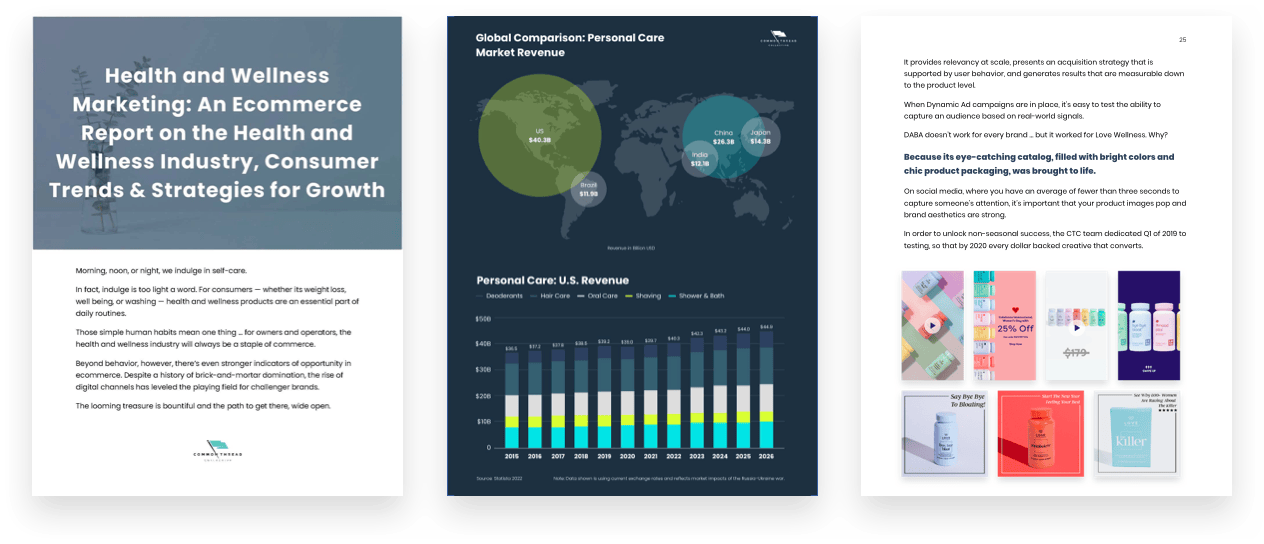
Don’t miss that final section …
There you’ll find detailed examples — packed with tactics and lessons — from three fast-growing ecommerce companies:
Supply
Selling razors at ~5x the industry’s usual price-point, Supply struggled with conversion rate and lifetime customer value.
Scaling the business internationally, creative iteration, and an exclusive membership program allowed Supply to jump the premium hurdle — resulting in 4.15x YoY growth.
Love Wellness
Record-setting holidays are one thing. To grow its business during the slower shopping periods of Q1 and Q2, this all-natural and “body-positive” supplement company had to get creative.
By testing content to improve performance, creating dynamic ads to a broad audience, and building product-specific landing pages, Love Wellness scaled to a 5x ROAS and increased first-time customers by 380%.
Snow Teeth Whitening
After expanding its oral care line, Snow wanted to reach new customers with an offer so attractive that it would sell out its inventory.
By driving visitors and then remarketing to those who showed interest with Facebook advertising, its product launch sold out and resulted in a 2.4x increase in purchases.
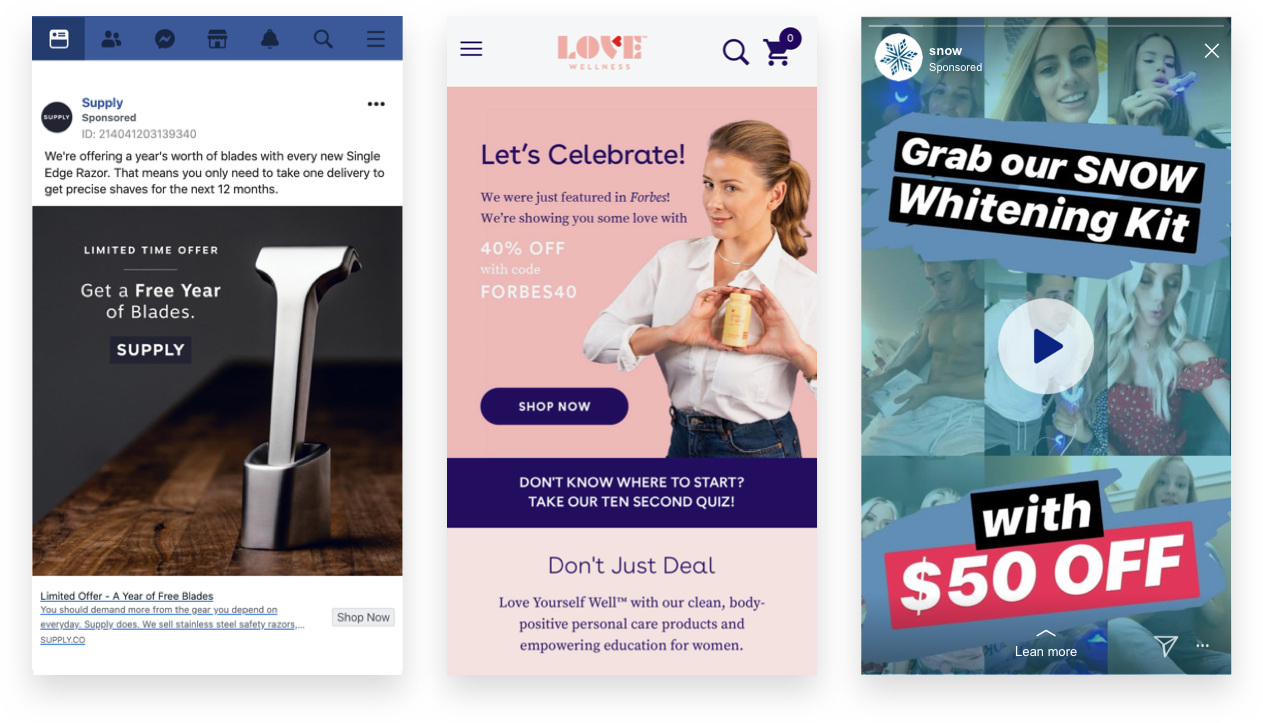
Global Health & Wellness Industry Consumer Trends
Globally, the industry is strong and tracking toward considerable expansion. At an average annual growth rate of 9.9%, the wellness economy is expected to hit $7 trillion by 2025.
Rising income and living standards contribute to high demand. With the health and wellness industry generating 5.3% of global economic output.
However, even as absolute revenue and total addressable market increase, growth itself has stalled over the past few years, despite the bump during the pandemic’s peak.
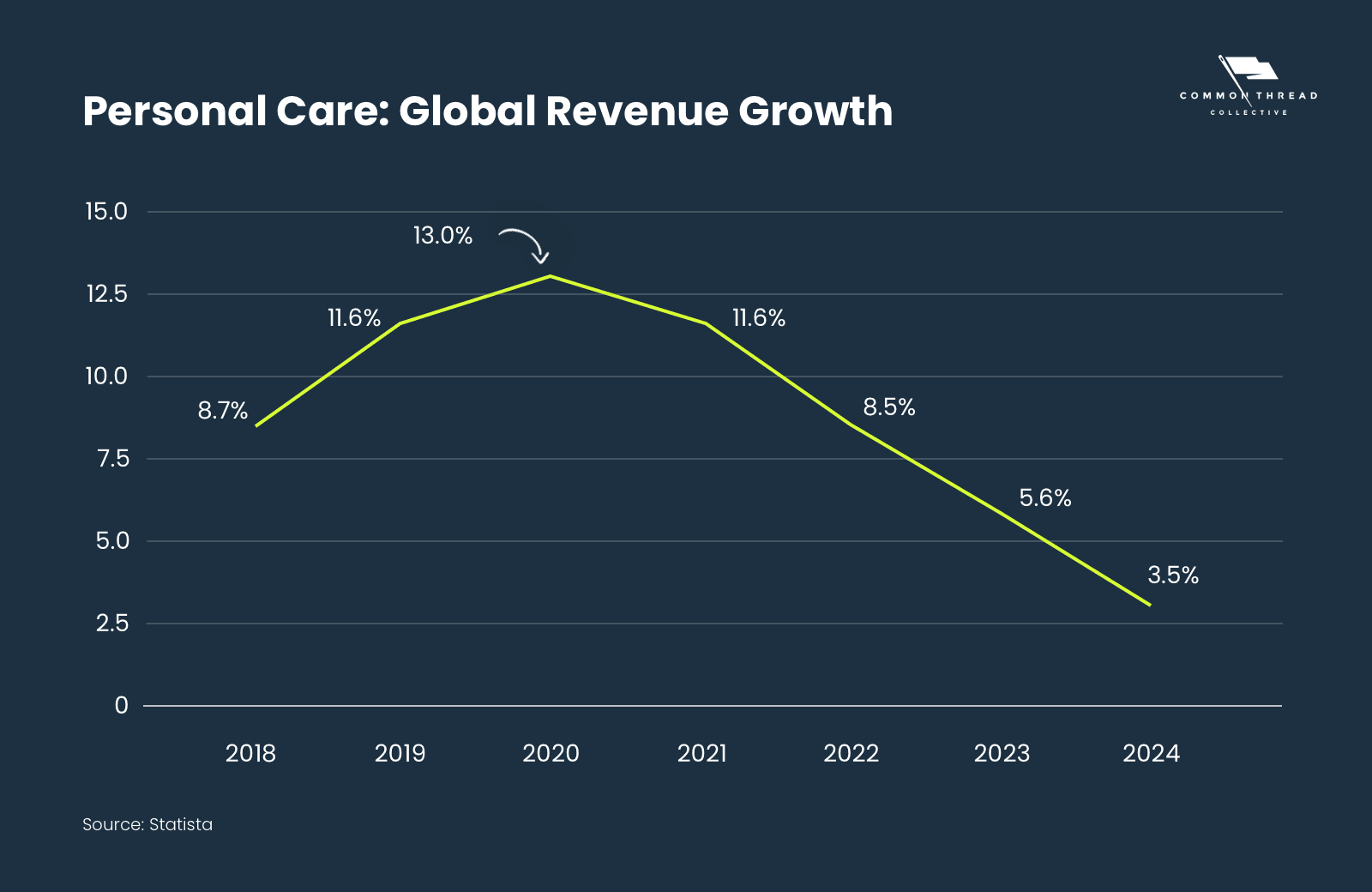
In other words, the time is now for upstarts eager to gain market share.
Of any global markets to penetrate, the most promising are the United States and China. In 2022, sources calculated those two markets at $66.6B of the world’s spending. Revenue for these goods in the U.S. has steadily risen year after year.
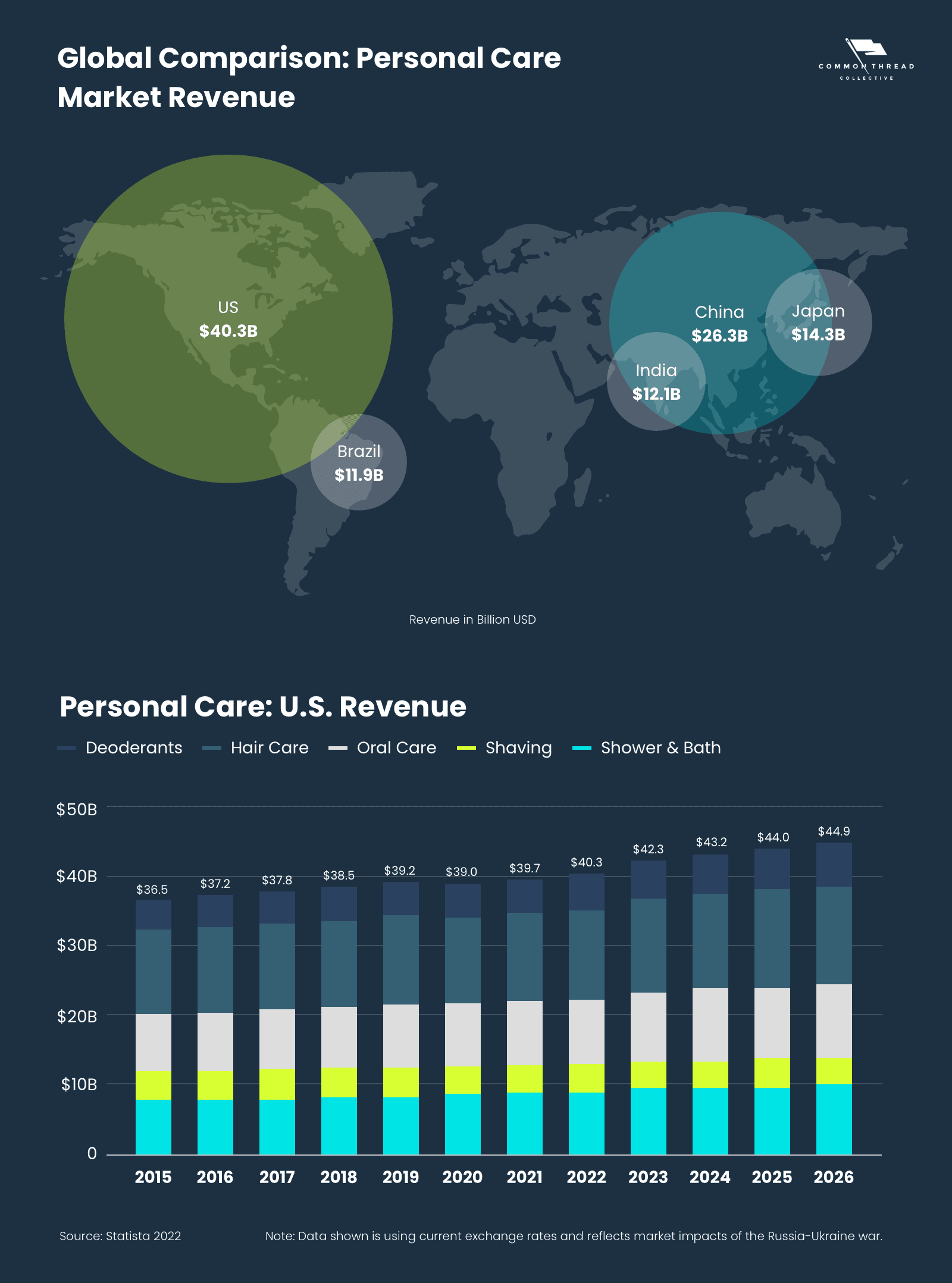
Although growth has always been upward, in the United States, volatile percent changes for consumer health and wellness sales are finally leveling out. 2023 is poised to be the first year sales rise above pre-pandemic percent growth rate.
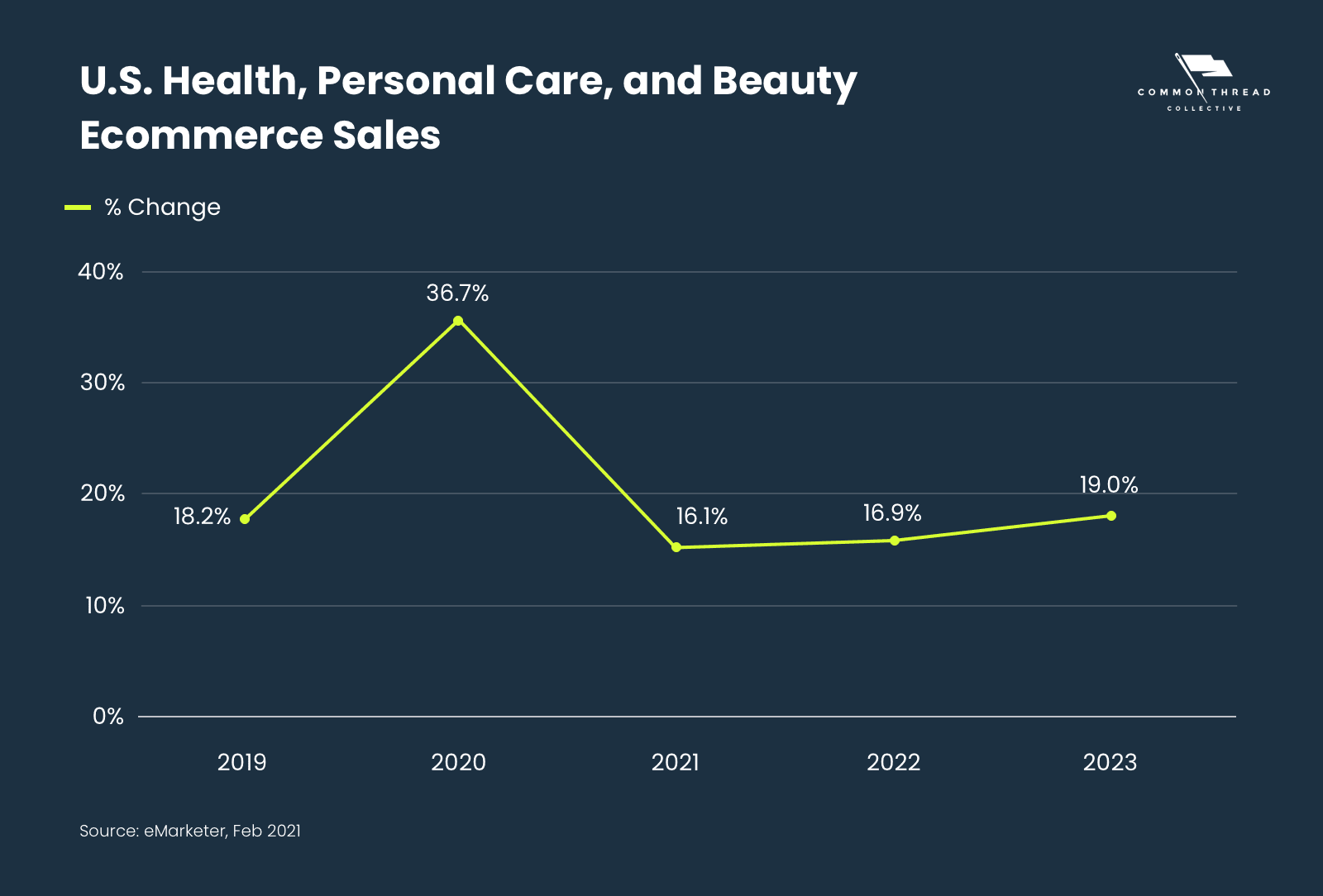
Health and Wellness: Consumer Insights & Verticals
Aside from strong revenue and far-reaching market share, the greatest advantage for personal care brands is lifetime customer value.
Why? Because products under the industry umbrella are habitual in consumers’ routines — and, even more lucratively, can lead to high repeat purchase rates.
More importantly, consumers view personal care products as essential for maintaining health.
Since wellness purchases are born out of both actual and perceived necessity, the high growth in spending highlights a willingness from consumers to spend continually and often.
Understanding your product’s place in a consumer’s wellness routine thus becomes utterly influential.
Here, we’ll major on the personal care segment of the larger health and wellness industry — which includes products such as hair care, skincare, oral care, bathing, nail care, shaving, wellness supplements, and deodorants.
Going a bit deeper than before, two verticals reap disproportionate benefits in sales relative to the industry average: soap and skincare.
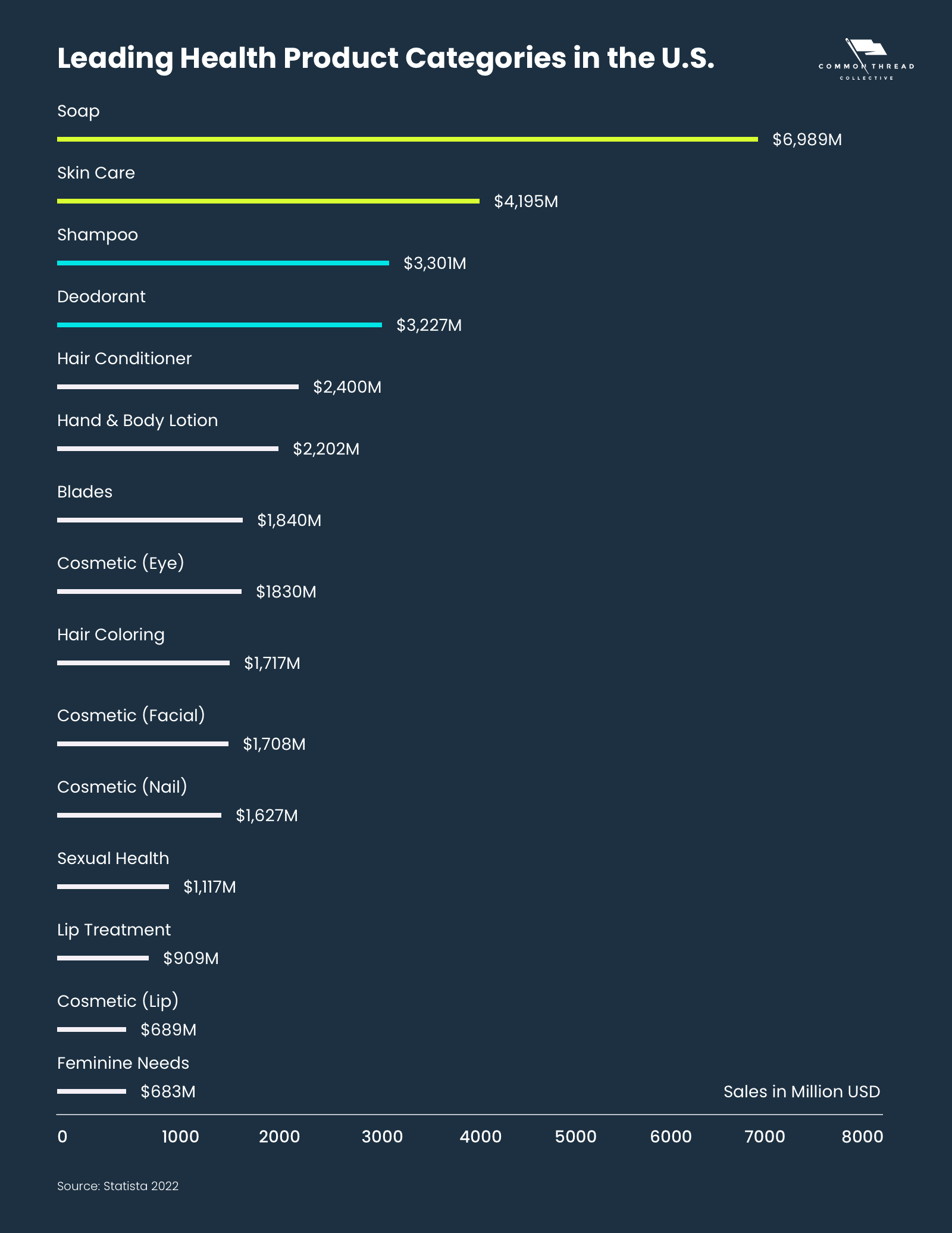
The leading health and personal care product category in the US is soap, with sales generating almost $7 billion.
Aside from understanding the role of your product in consumer’s lives, it’s equally important to learn how they found it to begin with.
Knowing that personal care behavior is ritualistic, capitalize on improving their shopping experience.
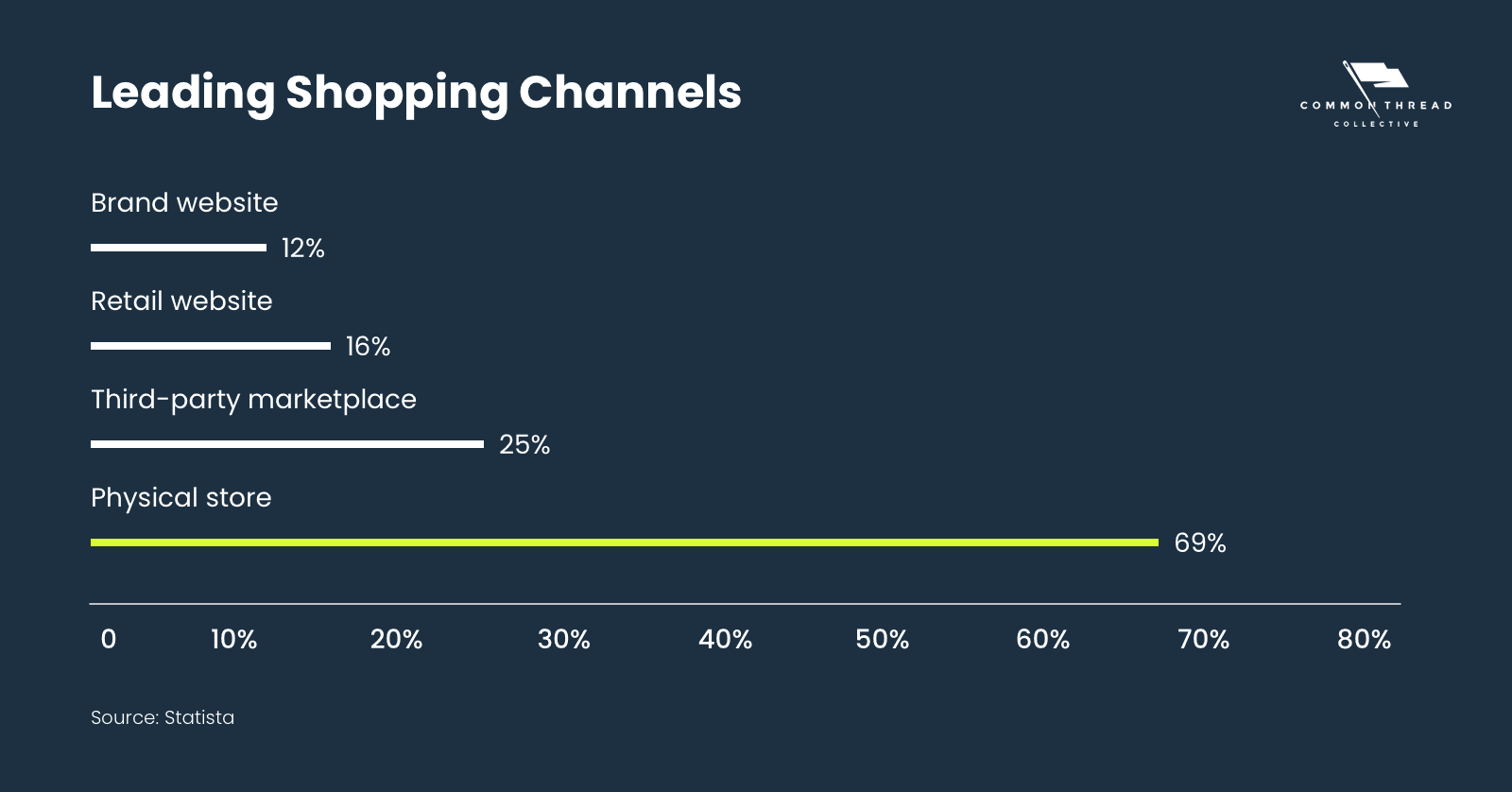
As a majority of consumers still shop for personal care products in physical stores, upstarts looking to challenge legacy chains can offer the advantage of saving time and avoiding crowded stores in customers’ routines …
If they look to ecommerce.
Ecommerce: Health & Wellness Online Sales & Trends
Personal care has catapulted online in recent years, offering convenience, competitive pricing, and wide product selection compared to brick-and-mortar retailers.
Many factors contribute to the growth of ecommerce. None more compelling than the fact that there’s plenty of room for it.
Today in the US, 34% of all health and personal care sales occur online. It's on course to rise to almost half of all wellness sales by 2025.

The turn to online retail demands a forward-looking strategies.
Because personal care products are bought on a regular basis, features like scheduled home delivery or subscriptions can drive retention.
“These items lend themselves well to ecommerce because you don’t have to worry about perishability, and they’re often replenishment items that can be re-purchased with one click,” stated eMarketer senior forecasting analyst Cindy Liu.
“You also don’t need to visit a retail store to see and touch the products because you know what you are getting every time you buy.”
A rise in consumer preference for social shopping coupled with online discovery will continue to lift the ecommerce tide.
As brands sidestep traditional models and opt instead for DTC, consumers follow.
In fact, in 2021, 74.3% of the American population purchased goods online. This was an increase of around four percent compared to 2019, and two percent since 2020. It’s estimated that this share will grow to 80.4% by 2025.
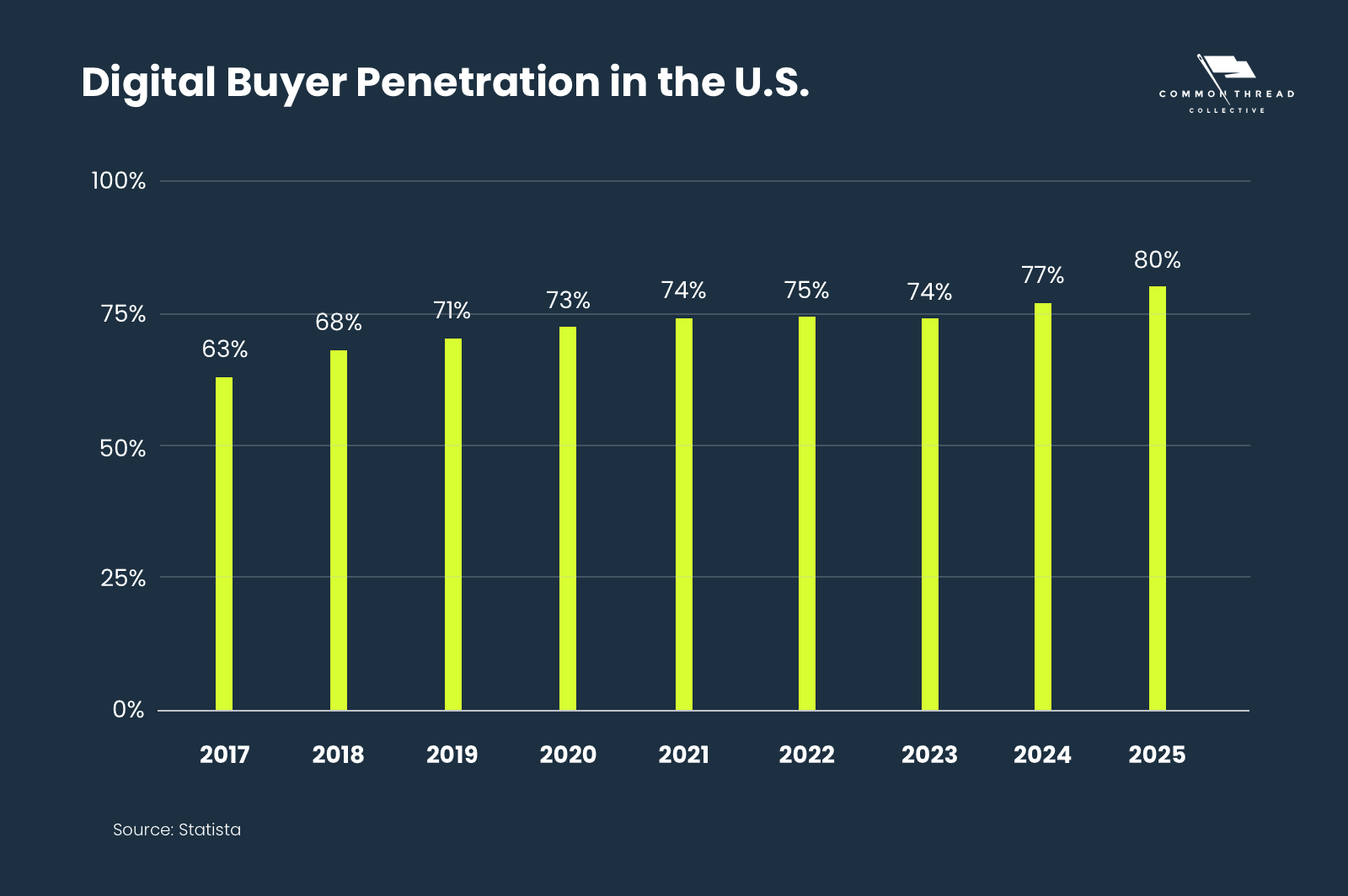
Likewise, product cycles are also speeding up, especially in the health industry. This poses a potential challenge for both legacies and newcomers.
Consumer Goods Forum found that 180,000 products globally were redesigned to meet consumer demands for healthier diets and lifestyles — nearly 8x that of reformulations in years prior.
Though consumer demand for purchase is promising, brands that maintain a grip on the market are those with the capacity to reformulate to meet consumer’s changing demand for product quality.
Amazon
Threats in the ecommerce space might not be coming from legacy brands just yet. They are, however, coming from Amazon.
The giant generated $131 million in personal care sales.
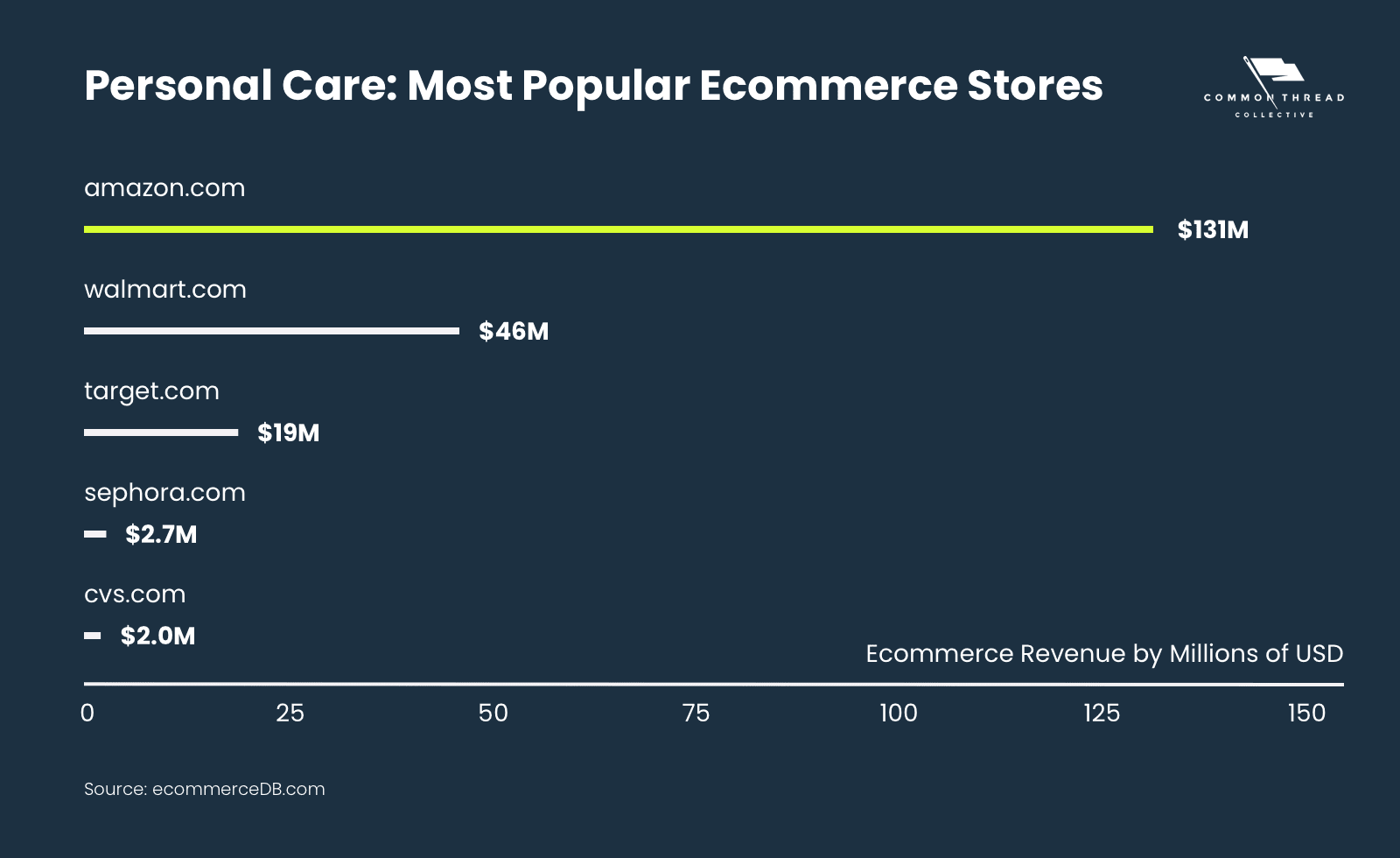
Amazon is putting on more pressure with its release of private-label goods.
But, there’s still hope. Although consumer packaged goods made up 41% of private-label sales, in comparison, personal care comprised only 2% of sales.
The market share is wide open to DTCs looking to rival Amazon’s success… if they follow an online marketing strategy focused on holistic growth.
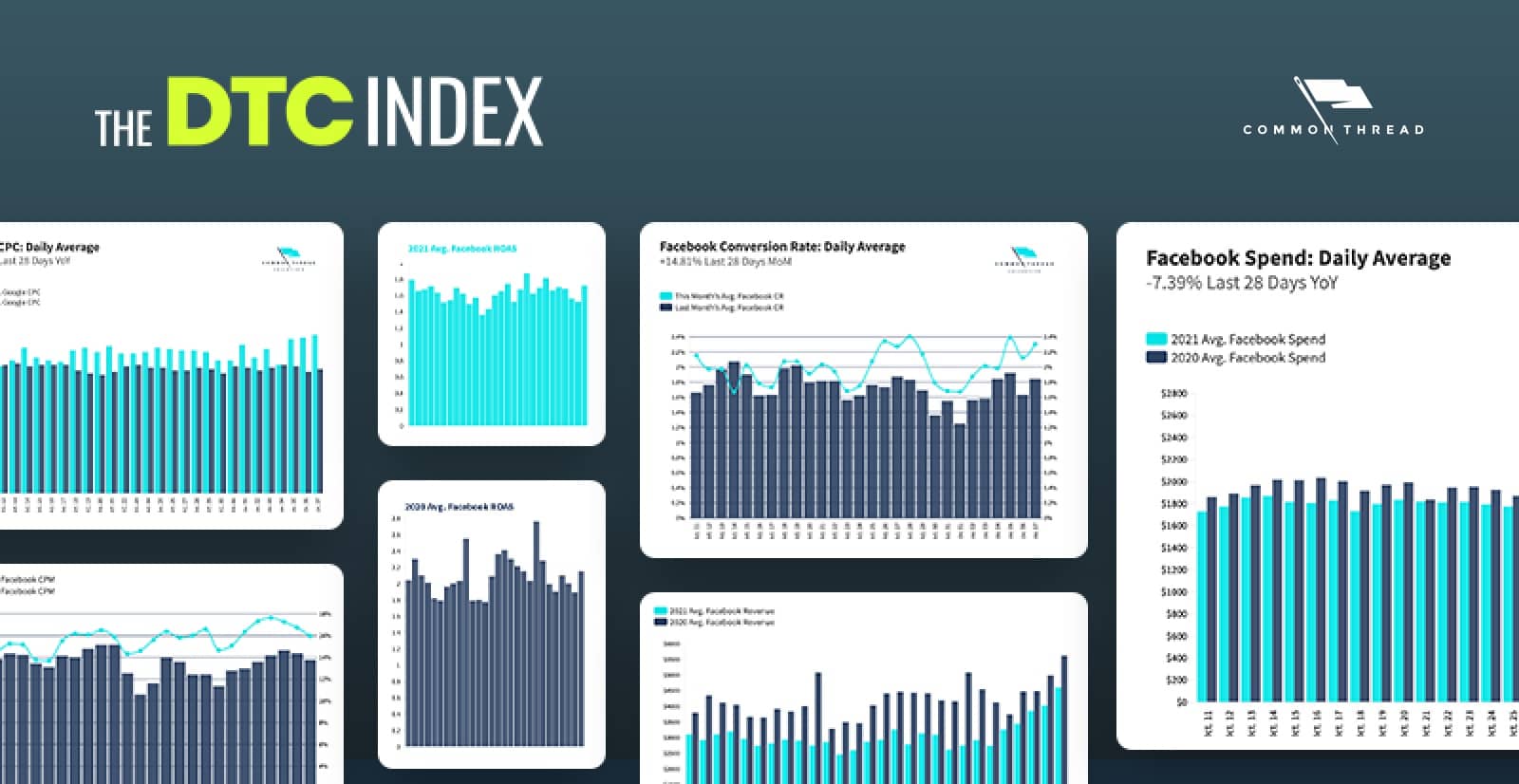
Want weekly Health & Wellness data updates delivered to your inbox?
From store CAC to Facebook ROAS, the DTC Index contains charts tracking year-over-year data points from all parts of the funnel.
Growth: Profitable Health and Wellness Ecommerce Marketing
When growing a wellness brand profitably, only four metrics matter: visitors, conversion rate, lifetime value, and variable costs.
We call it the …
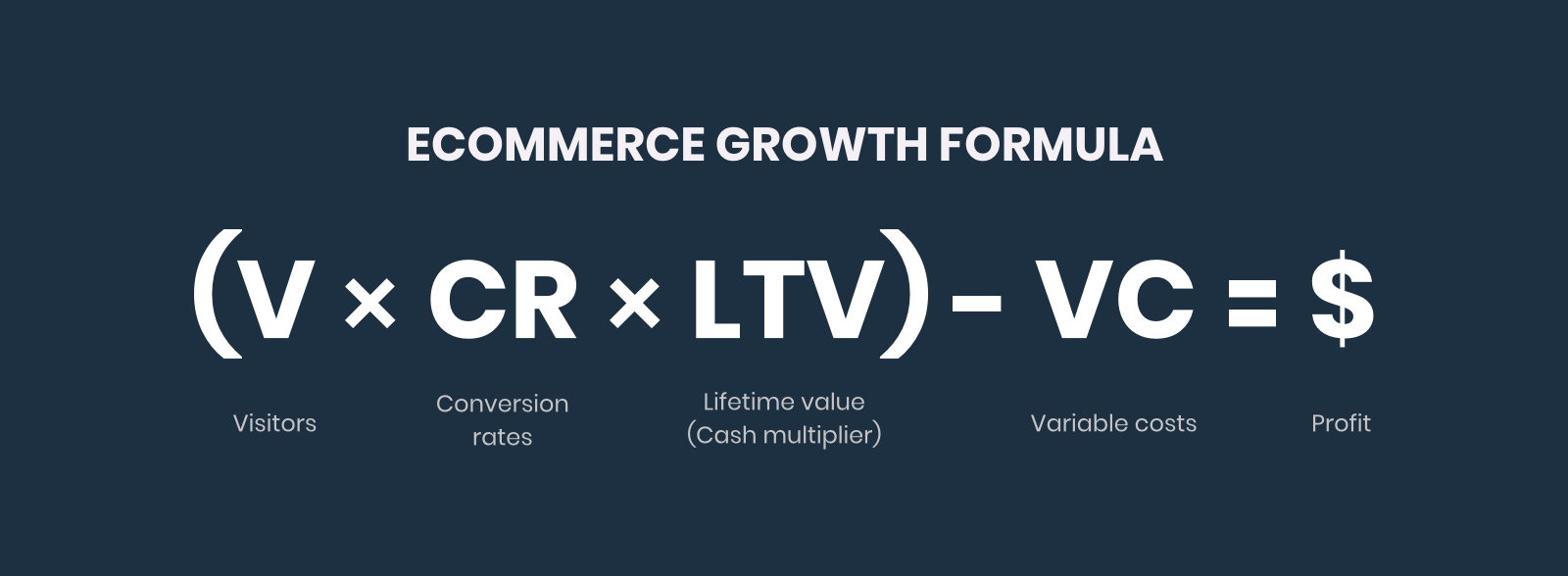
There’s no other way to drive profits than to affect one of these four variables — pushing them forward through a strategy built for growth.
Visitors: Driving Traffic
Drive new and returning customers (your target audience) to your online store across every distribution channel available.
Digital Marketing & Social Media
As social media increases in its importance of driving online sales, a digital-first marketing strategy is critical to success.
To be sure, organic social media content can build a loyal following and engaged audience. Yet, to convert that target audience, paid media is critical to the success of marketing efforts for health and wellness brands.
On the creative side, begin by determining what makes your product visually intriguing. Then, test that in your ad creatives.
To develop a social media buying strategy, start by calculating your numbers by examining customer cohorts:
- What are people doing post-purchase?
- Are they coming back?
- If so, how many and how long does it take?
Utilize this data to come up with a spend strategy that aligns with your cash flow and goals.
Influencers
By utilizing influencers, brands in the space can:
- Maintain an ongoing organic social conversation
- Build out a highly-converting content library
- Expand their audience pool within the exact niche they’re targeting
In an industry where product results are of utmost importance to gaining consumer’s trust, video is a powerful medium for authentic storytelling.
“It’s easy to fake affinity for the product or brand through a still image or written copy. By having the influencers create video content — the authenticity, or lack thereof, will be clearly seen,” says Cody Wittick of Kynship, an influencer marketing agency.
“Include influencer testimonials, such as ‘this product made me feel [blank]’ or ‘I loved this about it.’”
Aside from social media, an influencer marketing tactic that gets overlooked is the unboxing experience.
Create a great first impression with the influencer by sending something special to them. If you don’t have the budget, write a handwritten note. Personalizing the experience will increase affinity and the resulting content will reflect that genuineness.
To utilize search engine marketing (SEM) tactics within your digital marketing strategy, start with Google Performance Max campaigns.
Google’s newest advertising system can unlock major success for health and wellness digital marketing.
PMax includes five major benefits (read more here):
- The system fully leverages audiences
- Creative assets become more streamlined
- Automation reaches consumers at the “messy middle”
- Value-based bidding gets more bang from your budget
- Intuitive data means better forecasting & optimization
Wellness brands specifically should leverage “Maximize Conversions” or “Target ROAS” bidding strategies within their PMax campaigns.
Aside from these two SEM tactics, watch out for low-AOV products representing a large portion of your clicks or impressions from your Google campaigns.
“Most of our heath and wellness clients have quite a few SKUs, but a small percentage of those account for the majority of sales or profit,” says VP of Customer Success, Tony Chopp.
“If you have 100 SKUs — but only 20 of those are key drivers or high margin — then think about only advertising those core products on Google.”
Conversion Rate
Acquire new customers and increase AOV by optimizing your onsite experience.
From driving visitors through ads to the design experience, conversion rate encompasses the culmination of digital marketing efforts within your sales funnels to finalize a purchase.
Tactics to increase conversion rate include email capture, reviews, trust seals, user-generated content, subscriptions, and in-cart or post-purchase upsells.
Combined with site speed and mobile optimization, this allows for a seamless shopping experience.
Customer Lifetime Value
To build your business over the long term, the most important and often overlooked metric is your LTV or “cash multiplier” (CM).
Rather than thinking about the entire lifetime of your business, what are your customers worth in very specific payback periods?
Start by determining your 60-, 90-, or 120-day LTV. Then, execute a plan that fits your cash flow and builds your business over the long term. Tactics like memorable unboxing experiences or content marketing can generate an organic community of brand evangelists.
Email Marketing
Critical to improving your LTV and maximizing revenue, is maximizing retention through email marketing.
Leverage digital marketing strategies to drive visitors to your site, then pivot to a focus on customer retention.
Use their arrival to your advantage by encouraging subscriptions to your email lists, which will drive purchases further down the line if they don’t convert the first time around.
Whether your email subscriber is a future or past purchaser, mix two parts education and engagement with one part sales.
Drivers like loyalty or subscription programs are tactics that build a community around your brand and lead to upsells further down the line.
From welcome flows to post-purchase flows, ensure your messages speak to your brand and provide value to your consumer’s stage in the customer journey.
Variable Costs
If costs increase as orders rise, that’s a variable cost.
Opposed to fixed costs — like rent and operational overhead — VCs cover COGS, platform and payment processors, supply chain, fulfillment, and CAC: total spend including agency fees.
Strategy: Health and Wellness Marketing from the Top DTC Brands
Love Wellness
The Brand
Love Wellness is a one-stop-shop for women’s wellness, providing them with natural, organic, doctor-recommended solutions for vaginal and personal care.
From OTC suppositories for common infections to safe personal hygiene cleansers to a line of vitamin supplements for PMS and Total Body Care, Love Wellness offers a range of products to help you “take care down there.”
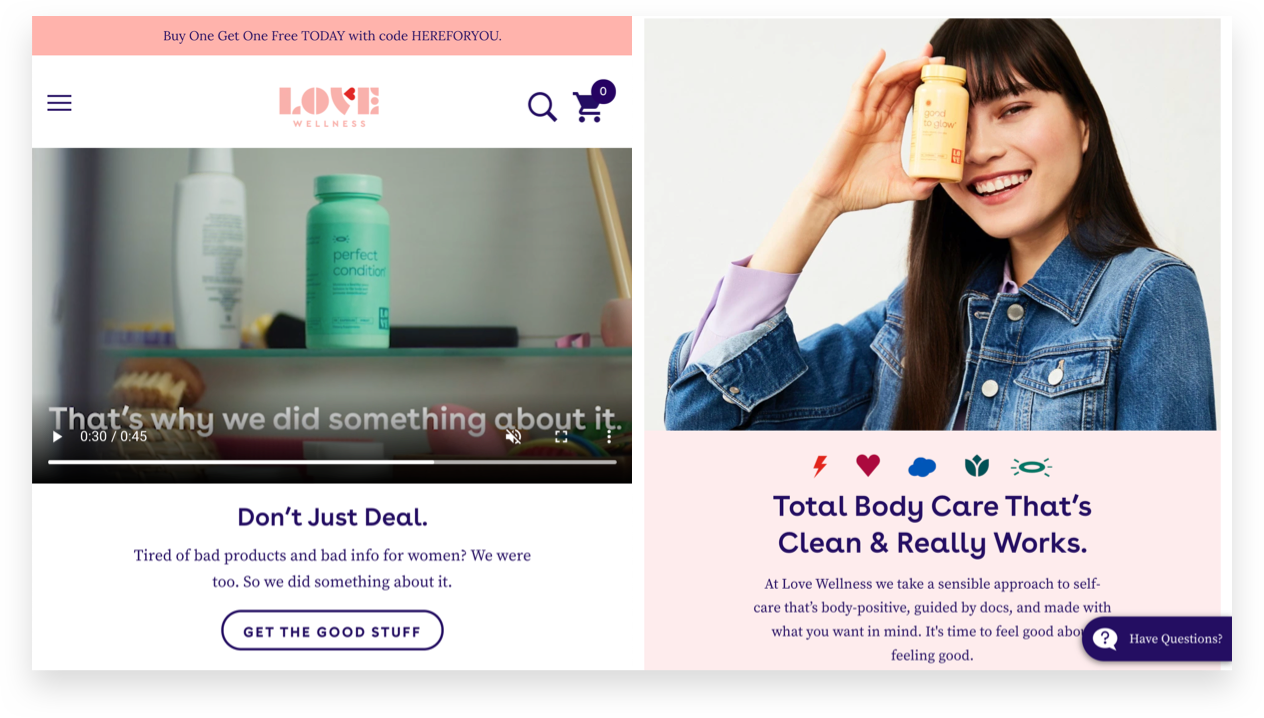
Founder, Lauren Bosworth had struggled to find solutions for herself that actually worked. As a result of her trials, Love Wellness was born.
The Challenge
Even though the brand had built a strong organic audience out of Bosworth’s fan following, to move into the next stage of business meant expanding its customer base.
And this meant spending on paid social at scale.
Not having spent much in the past, the brand teamed up with Common Thread Collective … and immediately set out to spend more in their first month than they had ever spent in the past combined.
Ambitious? Absolutely. But, Black Friday was coming fast.

The campaigns smashed, leading to the largest holiday season in the company’s history.
Of course, winning during the holidays is one thing.
Next up was tackling a strategy to grow the business during the slower shopping periods of Q1 and Q2 …
The Strategy
To garner meaningful new visitors, Love Wellness switched from engagement to a conversion-based Facebook ad campaign strategy.
This buying methodology was further bolstered by creating dynamic ads to a broad audience on Facebook (DABA).
It provides relevancy at scale, presents an acquisition strategy that is supported by user behavior, and generates results that are measurable down to the product level.
When Dynamic Ad campaigns are in place, it’s easy to test the ability to capture an audience based on real-world signals.
DABA doesn’t work for every brand … but it worked for Love Wellness. Why?
Because its eye-catching catalog, filled with bright colors and chic product packaging, was brought to life.
On social media, where you have an average of fewer than three seconds to capture someone’s attention, it’s important that your product images pop and brand aesthetics are strong.
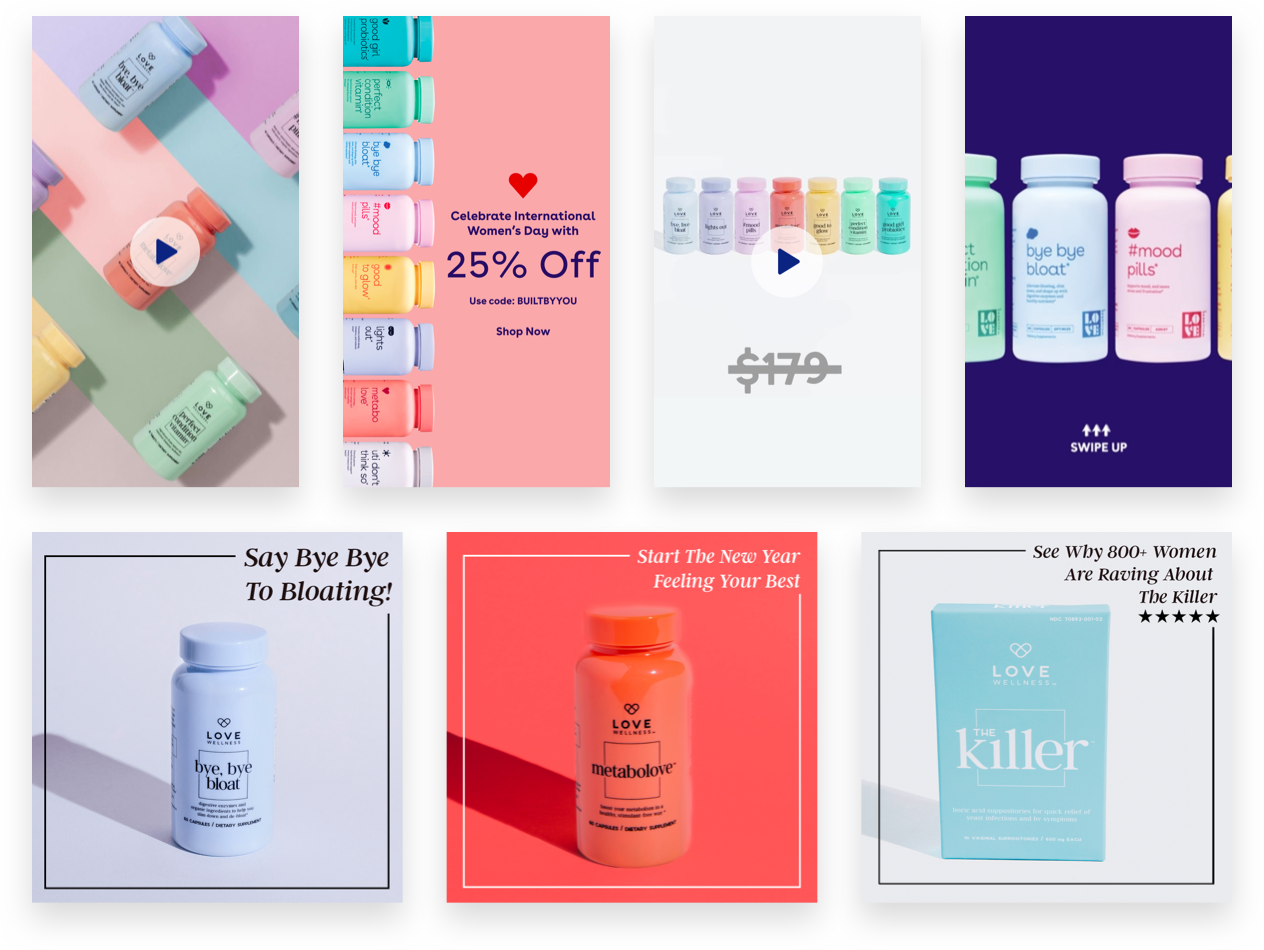
Perhaps even more important than image — good PR matters for health and wellness brands.
In a time of increased skepticism for buying consumables online, utilizing PR in Love Wellness’ ads has been a major key to gain the trust of consumers. It’s not easy to convince a person who has never heard of your brand before to take a supplement pill.
By utilizing a quote from Forbes along with other sources to validate the product, ROAS lifted significantly.
This key insight triggered obsessive testing of creative and copy to improve performance of best performing ads.
Early wins began stacking up fast …
- A quote from Forbes vs other publications: +80% ROAS
- A change of background from blue to white color: 2x ROAS
- A headline variation from “🙅🏻♀️No More Bloating 🙅🏻♀️” vs “Loved by Forbes, PEOPLE and ELLE Magazine”: +18% ROAS on 3x spend
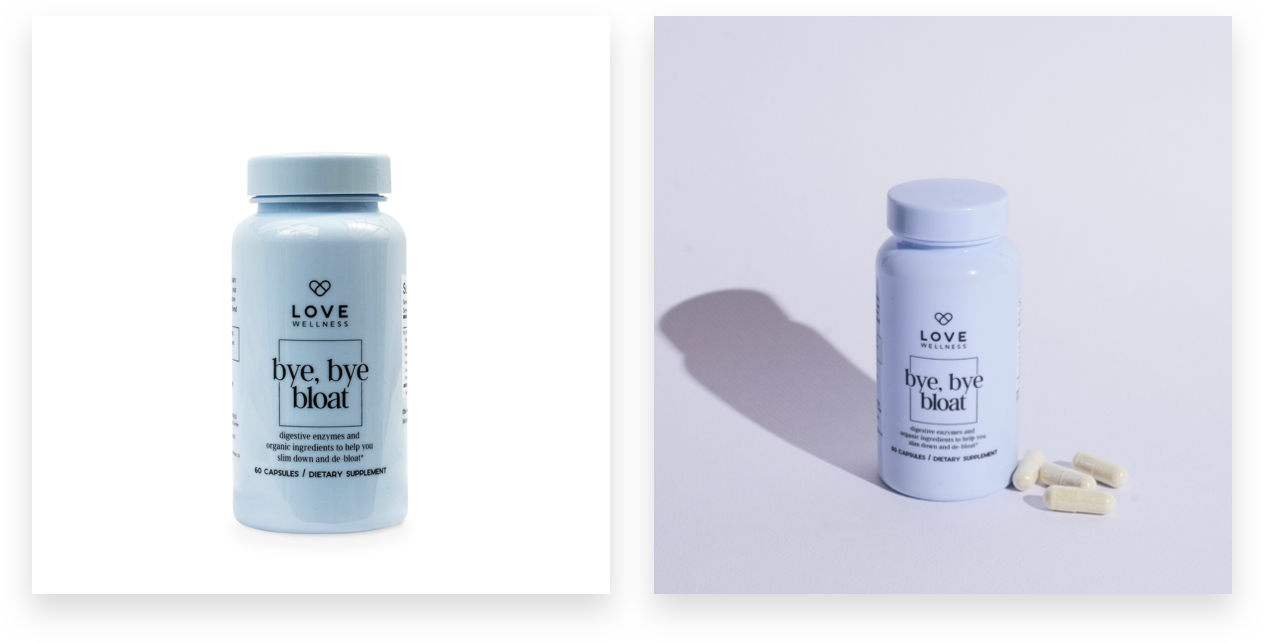
From value propositions to background color – these small creative changes had a huge impact.
The results solidified a focus on the product benefits in the copy as opposed to the packaging.
“We really started winning for them when we figured out which were the best products to use for prospecting and remarketing,” said Growth Guide, Michelle Luo. “We learned the power of strong copy and putting the product first.”
After creative testing, the team structured the account by SKU-specific funnels. Segmenting products into different ad sets, finding its best audience, setting individualized cost and bid caps led to far greater efficiency.
This focus on product led to the creation of ad-specific landing pages. It was no longer just about the creative.
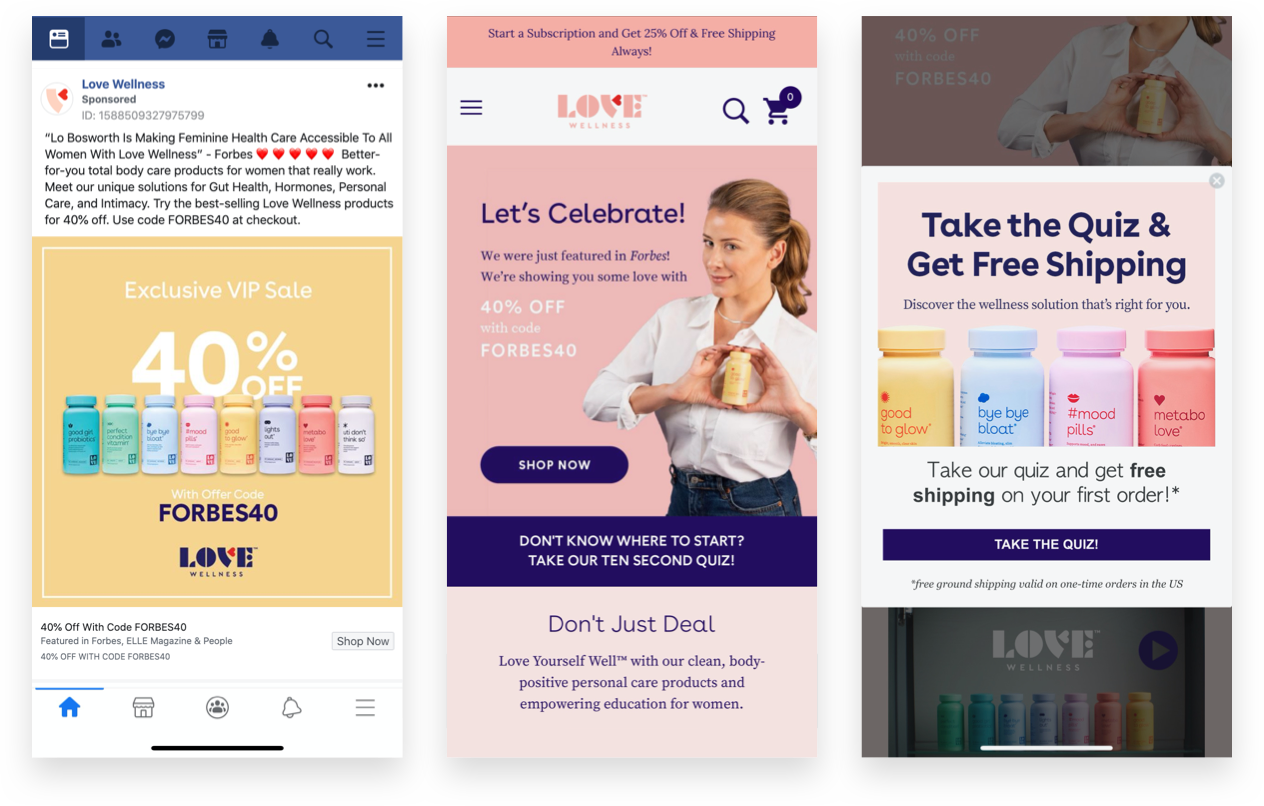
It was about the entire experience, from ad to landing page. Coupled with heat map tracking, conversion rates more than doubled.
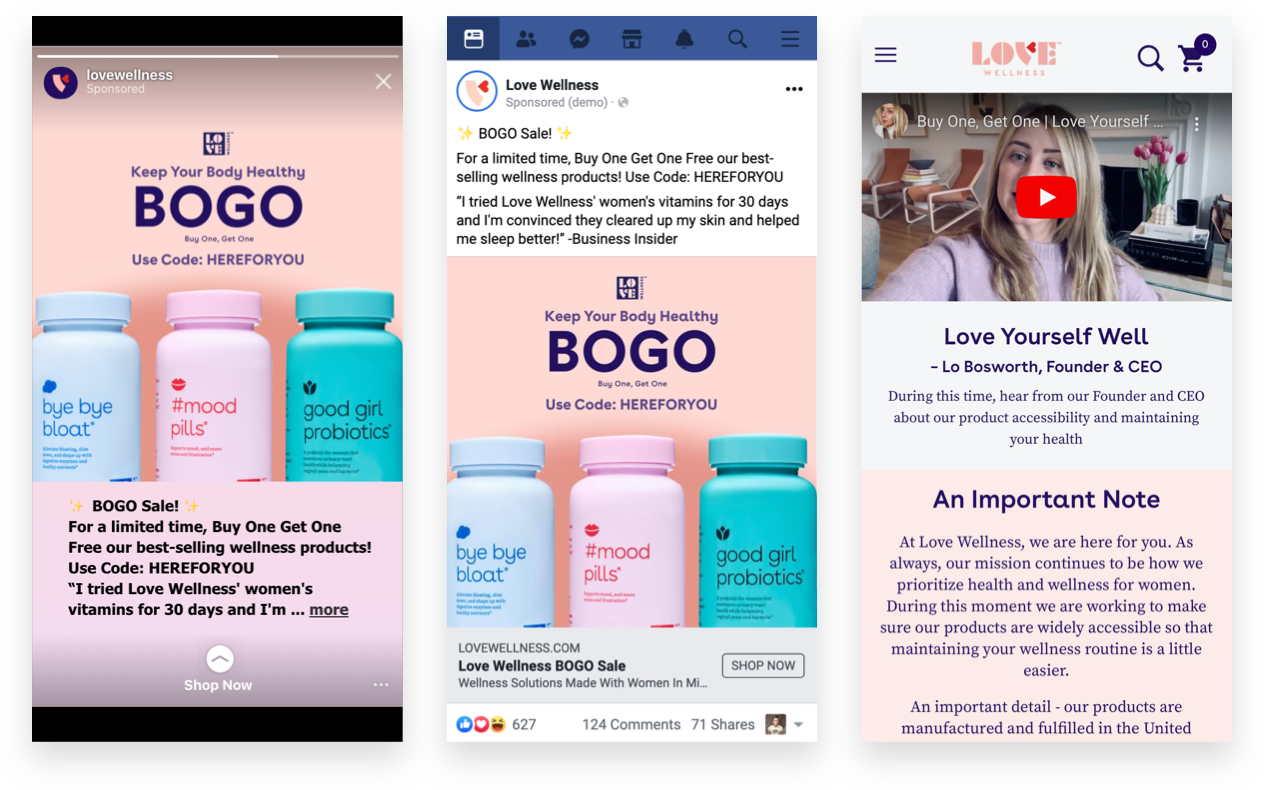
As a final touch, it also began closing the gaps on search. The tactic — lovingly referred to as the “Brand Lasso” — closed holes in the bottom of the funnel with Google Shopping.
For Love Wellness that meant a 33.3% increase in revenue from Google Ads.
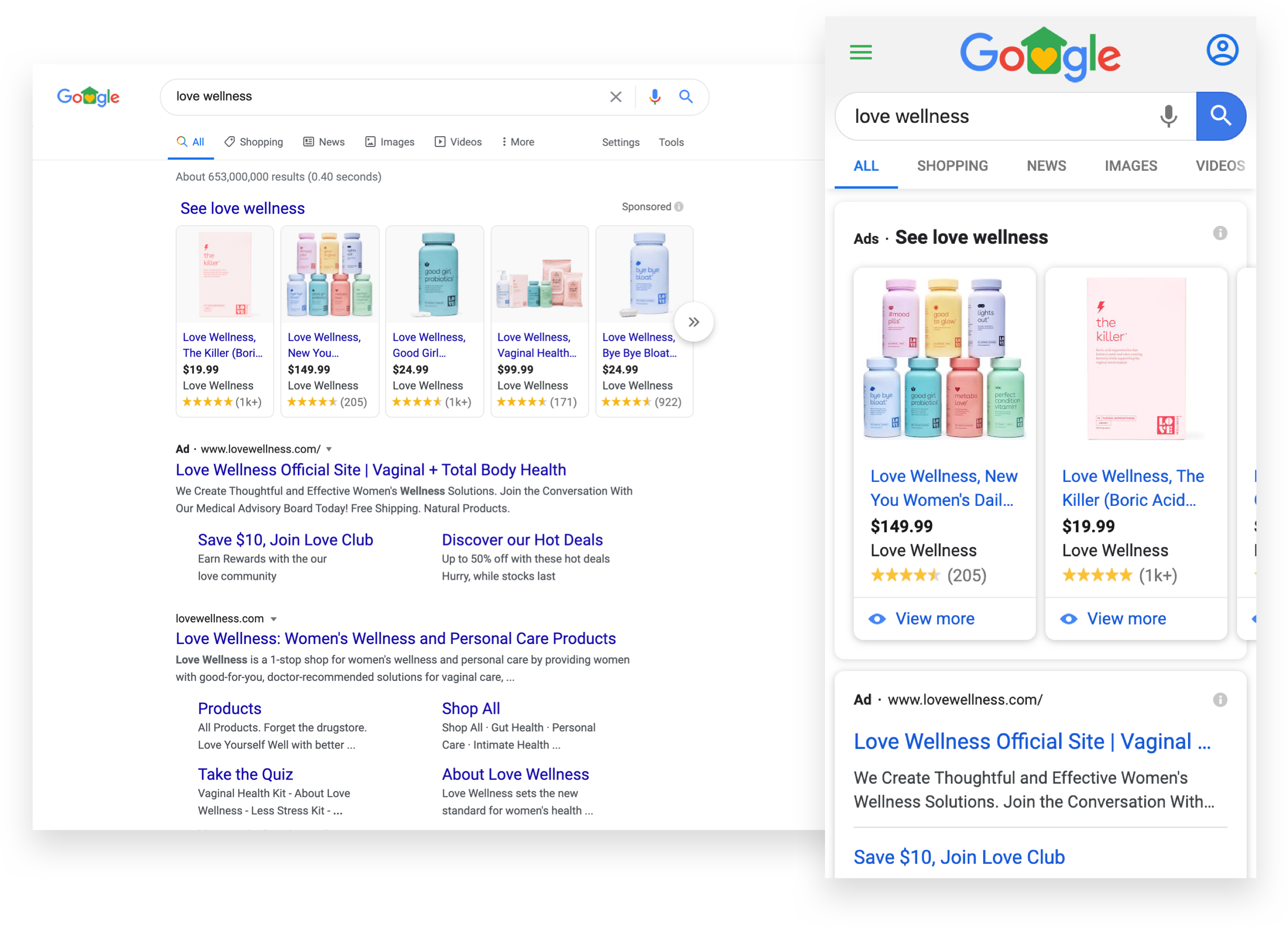
Detailed feed optimization and lower-cost traffic set a record high for gross revenue from Google Ads in a single month.
In total – by testing to improve performance, creating dynamic ads to a broad audience, and building product-specific landing pages – Love Wellness grew their business during what is normally a slow shopping season.
The Results
- 5x ROAS overall
- Addition 5x YoY increase in customer base
- 380% increase in first-time customers during Q1 and Q2
Supply
The Brand
Tired of products that consistently under-perform and constantly break down, Supply set out to build a brand that does things differently. Its flagship product is a high end, patented single-blade razor.

Run by a small husband-and-wife led team, who both quit their prior careers to pursue building the brand, Supply got its big break on Shark Tank.
There, Patrick and Jennifer Coddou received both praise and an offer from Robert Herjavec for $300,000: “It’s very, very difficult to elevate a commodity product with a premium value, and that’s what you’ve done.”

The next step was just that — elevating and growing a premium commodity through digital marketing efforts.
The Challenge
Supply’s single-edge razors clock in at ~5x the industry’s usual price-point. When it comes to conversion rate, price is the biggest friction
On the other hand, it’s built to last for 100 years: a major win for the consumer in terms of quality. But, it can also lead to a loss on the business-side, since customers literally won’t ever need to purchase the razor again.
That one-two-combo creates a double-edged … razor. Customer acquisition, the initial challenge; followed by the struggle of increasing the lifetime value.
And when COVID-19 hit … those challenges only intensified.
The Strategy
To win meant finding a way to incentivize shoppers without undercutting value.
Amidst spending more money on paid acquisition and reaching new customers, the core focus is on conversion rate.
“As we continue to scale, we want to hold our existing conversion rate, if not improve on the past,” said Growth Guide, Kyle Lawrence.
Incorporating conversion rate incentives, like Afterpay or Klarna, allow customers to “Shave Now and Pay Later” — reducing price friction.
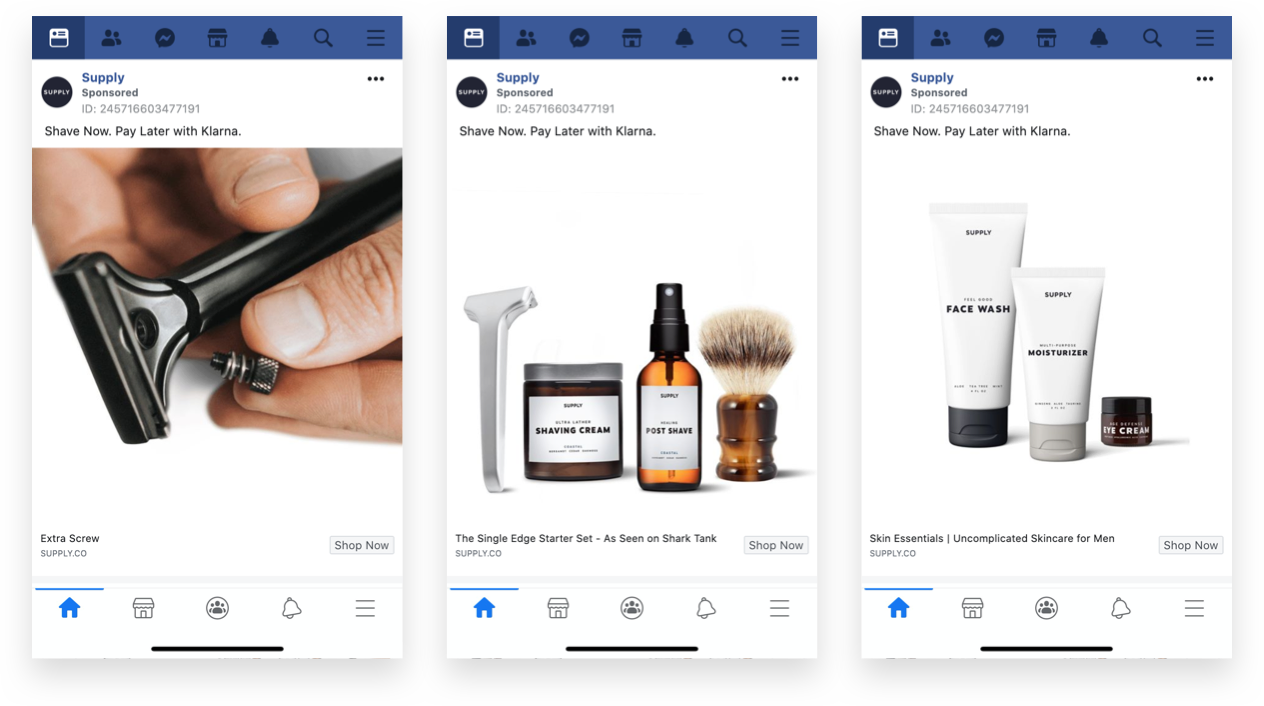
Usually, as brands reach broader markets, conversion rates drop since there is less customer familiarity. This holds especially true on an international scale.
As Supply looked to reach new markets, taking the brand worldwide was the next step.
“Early last year, we decided to duplicate our domestic ads, change the targeting from US to worldwide, set language to English, and hit go,” Coddou says.
“The end result was 30% of revenue came from international markets. From zero to $250k in Nov. alone. Obviously, there was a lot of tweaking and lessons, but that’s how it started.”
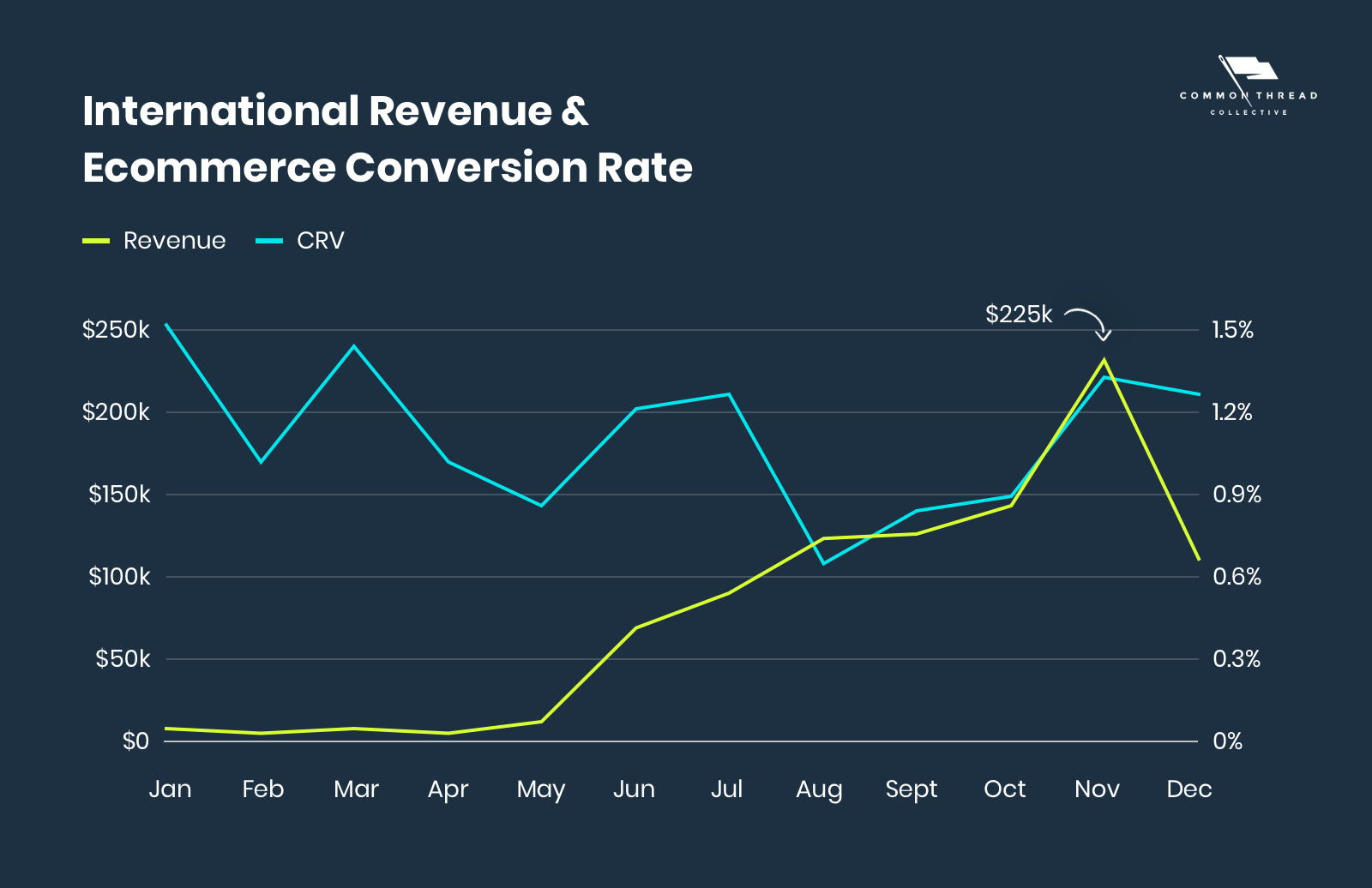
Between Jan. and May, the ads ran with essentially zero attention — miniscule impressions of around 100-500. In June, Coddou and CTC’s Director of Paid Social Trent turned up the spend and hit a 3.5 ROAS out of the gate.
So, they turned it up even more and Supply’s international as well as domestic returns held:
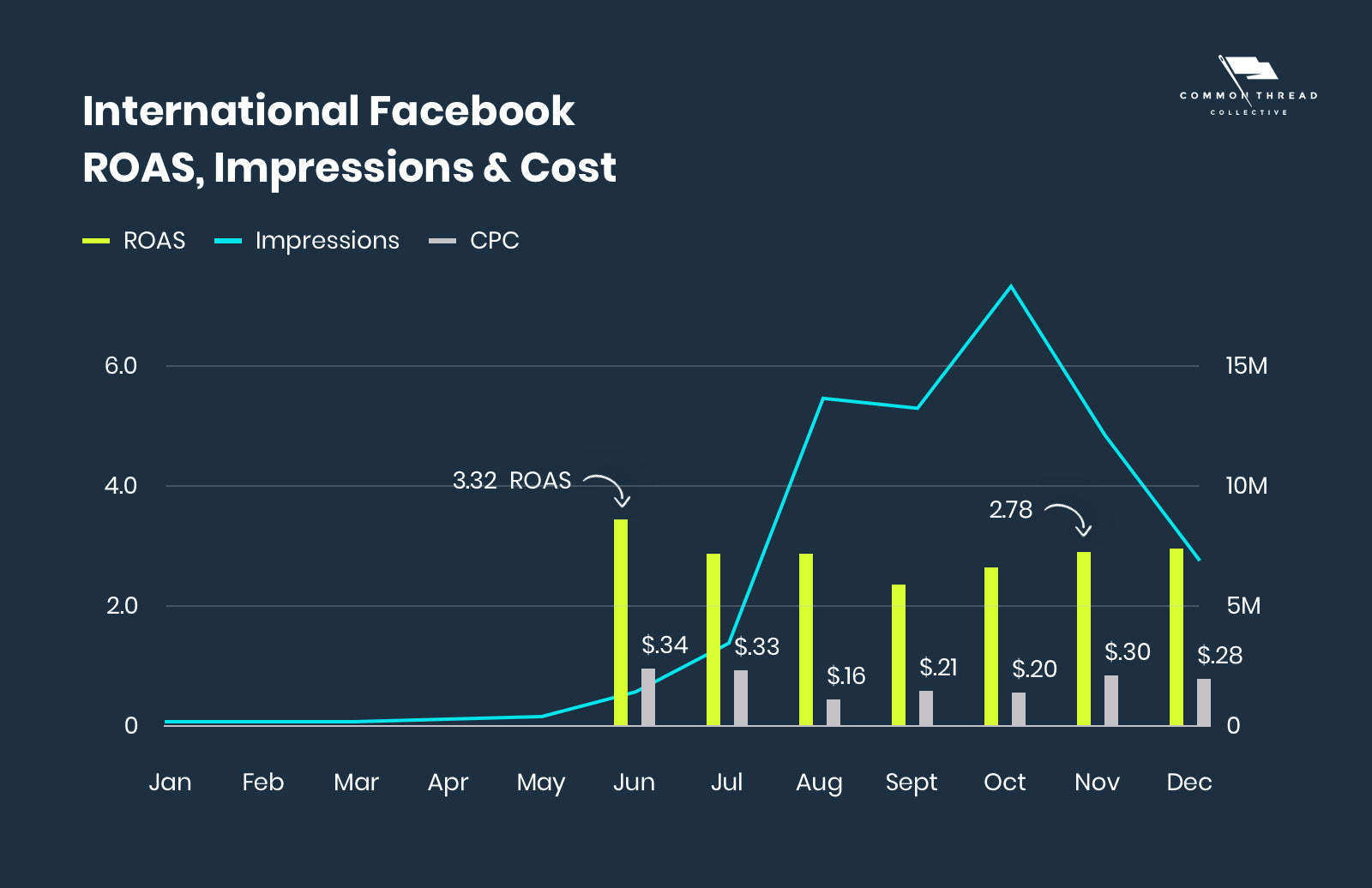
Yielding cheaper traffic and higher returns, the next step was to keep the conversion momentum moving domestically.
To cross the conversion gulf, Supply tested and iterated on multiple concepts.
The winner? A free year of blades with every new purchase:

After an initial 5.07 ROAS, the offer was combined with an educational landing page highlighting the free year of blades. Winning campaigns is one thing, but holding that scale is another.
“The key has been creative iteration, the right offer, and scaling rapidly. In all of that, CTC’s partnership has been irreplaceable.”
The Results
- 2.8 account-wide Facebook ROAS
- 4.4 Google ROAS
- 315.5% YoY growth
Snow Teeth Whitening
The Brand
Snow Teeth Whitening is an oral healthcare brand that focuses on bringing people confidence through a beautiful smile.
For the launch of its at-home teeth whitening system, they partnered with CTC to advertise it’s cutting edge technology.
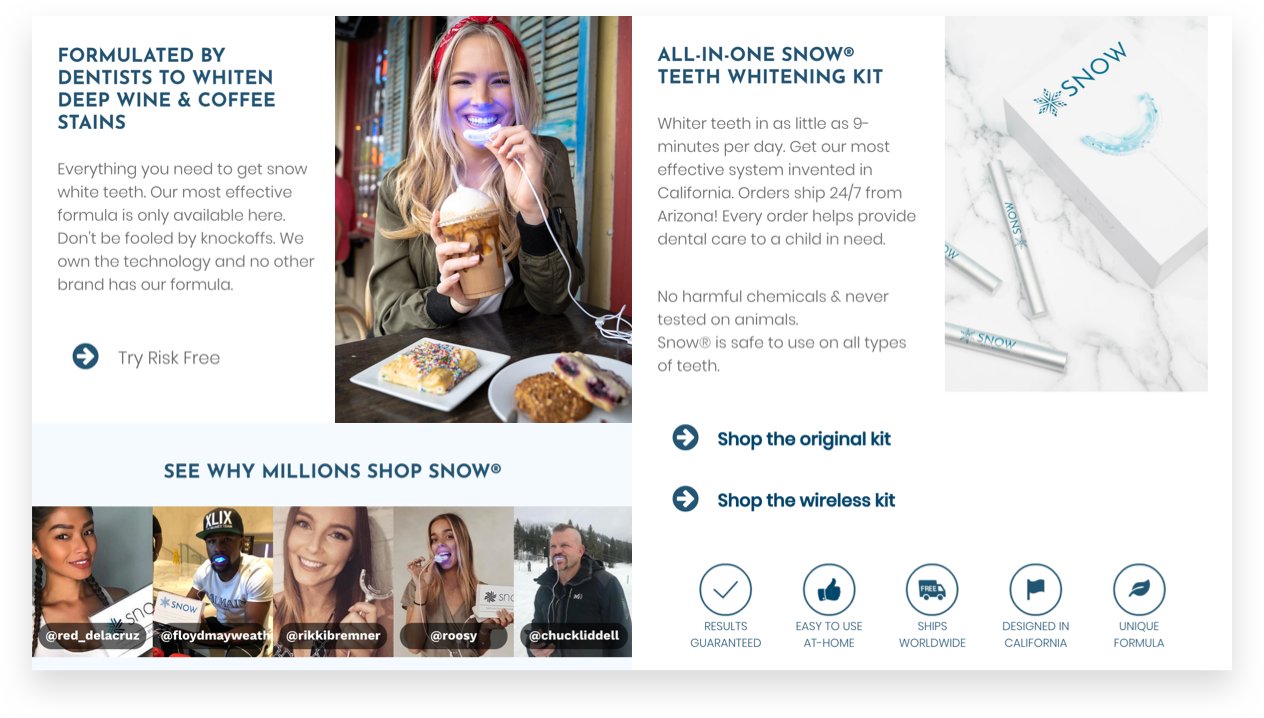
The product connects to a smartphone and uses unique LED tech for accelerated whitening. Its patented system even allows Snow’s customers to track their whitening progress via a mobile app.
With celebrity backing from stars like Rob Gronkowski and a charitable mission of donating a percentage of each sale goes to families who cannot afford dental care — the future was bright.
The Challenge
Expanding its oral care line and wanting to reach new customers … it set a bold goal.
Completely sell out the new product upon launch.
Selling out inventory is already hard enough. But, to add to the hurdle, it launched the product during the holiday season, amidst a crowded landscape of ecommerce businesses dominating market share.
To win, meant finding and converting new customers during the most competitive season of the year.
The Strategy
Snow’s strategy unfolded in two parts.
First, it focused 75% of its budget on finding new customers up until the day before Black Friday. Already home to a stable of influencers …

… the team leaned into that aesthetic and created pre-holiday-related video ads showing people using the product, backed by Facebook’s automatic placement and campaign budget optimization.
This allowed Facebook to automatically select the placement of the ads where they were performing best across Facebook’s family of apps and then allocate higher budgets to the ads that performed the best.
Second, the campaign switched gears to focus 75% of its budget on remarketing to people who had either viewed the video ads or engaged with Snow’s Facebook Page.
Utilizing Facebook’s campaign budget optimization (CBO) was key. Running a CBO campaign made the most efficient use of Snow’s spending to get it the overall best results and still ensured that the cost of those results aligned with the CTC team’s bid strategy.
Snow showed ads to these groups centered on BOGO: buy one, get one.
After Cyber Monday, it wasn’t over …
The team duplicated the Black Friday offer, creative, and ads. Then, tailored them to be more appropriate to the holiday season.
Since they were re-engaging with an audience that had become familiar with the brand, the messaging angle was congruent with their stage in the buying journey.

The final outcome? A total inventory sell out.
“By crafting a compelling offer and pairing it with Facebook’s ad platform, we were able to reach over 20 million Americans in Q4,” said Josh Elizetxe, CEO of Snow. “The impact of these campaigns has assisted Snow in becoming the leader in premium oral care.”
In addition …
The Results
- 1.7x overall ROAS
- 2.4x increase in purchases
- 23,000 families received free dental care as a result of company donations from these sales
The Right Partner: Do You Need a Health and Wellness Marketing Agency?
After growing brands like Love Wellness, Supply, Snow, and more we pride ourselves on being growth experts in every stage of the online sales process within health and wellness marketing.
From creative content to media buying, our solutions are specifically tailored to tweak the variables that create revenue.
If you’d like to take this article with you on the go, grab it as a PDF:

We won't send spam. Unsubscribe at any time.
